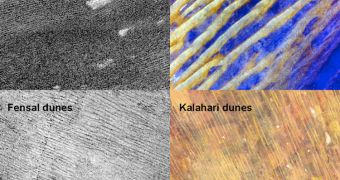Saturn's largest moon, Titan, is of great interest to astronomers because it's the most Earth-like object in the solar system. One of the most recent studies conducted on the body was aimed at surveying its dunes using radars, and experts say that this allowed them to learn more about the moon's past climate.
According to the international research team – which features scientists from the NASA Jet Propulsion Laboratory (JPL), the European Space Agency (ESA) and the Italian Space Agency (ISA) – it would appear that these dunes hold a lot of clues on the nature of Titan's geological history.
Previously, the NASA Cassini spacecraft only focused on the sand dunes in passing, in the sense that experts rarely allowed its radar instruments to observe the world in detail. However, the new investigation was conducted specifically to survey the moon's Earth-like dunes.
An interesting thing about them is that they are extremely large, when compared to those found on our planet. They can reach a length of hundreds of miles, a width of up to 1.2 miles (2 kilometers), and sometimes grow to be around 330 feet (100 meters) tall, Space reports.
Experts say that the way in which these dunes are disposed geographically speaks volumes of the climate and geologic history that led to their formation. Dunes in Namibia and the Arabian Peninsula resemble those on Titan closely, even though they are significantly smaller.
An important conclusion drawn from analyzing the way dunes and liquid hydrocarbon lakes are located on Titan is that the soils and the air become moister at high latitudes. The dunes, for example, are confined between 30 degrees latitude north 30 degrees latitude south.
A moister atmosphere also makes sand more difficult to carry on wind. Furthermore, the sand itself is not made up of silica, as it is on Earth, but most likely out of solid hydrocarbons that precipitated out of the atmosphere.
Another reason why sand dunes are confined by mid-latitudes could be Saturn's elliptical orbit. The gas giant exerts a huge pressure on its moons, especially large ones like Titan. For instance, each season on this moon lasts for roughly 7 years, since Saturn takes 30 years to orbit the Sun.
“Understanding how the dunes form as well as explaining their shape, size and distribution on Titan's surface is of great importance to understanding Titan's climate and geology because the dunes are a significant atmosphere-surface exchange interface,” Nicolas Altobelli explains.
“In particular, as their material is made out of frozen atmospheric hydrocarbon, the dunes might provide us with important clues on the still puzzling methane/ethane cycle on Titan, comparable in many aspects with the water cycle on Earth,” the ESA Cassini scientist concludes.

 14 DAY TRIAL //
14 DAY TRIAL //